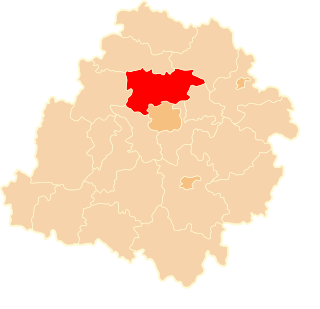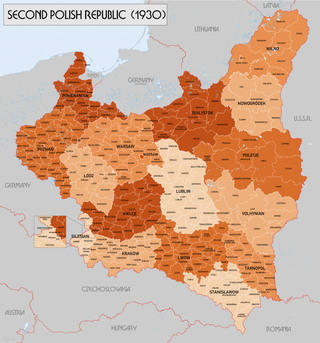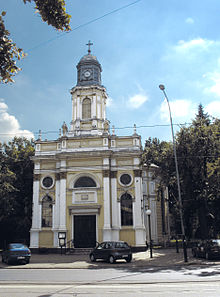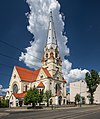
Łódź is a city in central Poland and a former industrial centre. It is the capital of Łódź Voivodeship, and is located 120 km (75 mi) south-west of Warsaw. As of 2023, Łódź has a population of 655,279, making it the country's fourth largest city.

Łódź Voivodeship is a voivodeship (province) of Poland. The province is named after its capital and largest city, Łódź, pronounced.

Ozorków is a town on the Bzura River in central Poland, with 19,128 inhabitants (2020). It has been situated in the Łódź Voivodeship since 1919.

Węgrów is a town in eastern Poland with 12,796 inhabitants (2013), capital of Węgrów County in the Masovian Voivodeship.

Tuszyn is a small town in Łódź East County, Łódź Voivodeship, central Poland, with 7,237 inhabitants (2020). It is located in the Sieradz Land.

The Polish Reformed Church, officially called the Evangelical Reformed Church in the Republic of Poland is a historic Calvinistic Protestant church in Poland established in the 16th century, still in existence today.

Zgierz County is a unit of territorial administration and local government (powiat) in Łódź Voivodeship, central Poland. It came into being on January 1, 1999, as a result of the Polish local government reforms in 1998. Its administrative seat and largest town is Zgierz, which lies 9 kilometres (6 mi) north-west of the regional capital Łódź. The county contains four other towns: Ozorków, lying 16 km (10 mi) north-west of Zgierz, Aleksandrów Łódzki, lying 9 km (6 mi) south-west of Zgierz, Głowno, 24 km (15 mi) north-east of Zgierz, and Stryków, 15 km (9 mi) north-east of Zgierz.

On 1 April 1938, borders of several western and central Voivodeships of the Second Polish Republic changed considerably. This included such Voivodeships as Pomerania, Poznan, Warsaw, Lodz, Bialystok, Lublin and Kielce. Pomerania gained most, while Bialystok lost most. This is the alphabetical list of powiats (counties), which were then moved from one Voivodeship to another:

Chodecz is a town in Włocławek County in the Kuyavian-Pomeranian Voivodeship in central Poland. It is situated midway between Lubień Kujawski and Przedecz. It is about 75 km (47 mi) north of Łódź, 150 km (93 mi) west of Warsaw and 28 km (17 mi) south of Włocławek. The southwest side of Chodecz borders on Lake Chodeckie. As of December 2021, the town has a population of 2,244.

Rzgów is a town in Łódź East County, Łódź Voivodeship, in central Poland, with 3,382 inhabitants (2020). It is situated on the Ner River within the Sieradz Land. The town is a member of Cittaslow.

The Evangelical Church of the Augsburg Confession in the Republic of Poland is a Lutheran denomination and the largest Protestant body in Poland with about 61,000 members and 133 parishes.

Łódź Voivodeship was a unit of administrative division and local government in Poland from 1919 to 1939. At the time, it covered a large portion of the mid-western part of the country, including such cities as Łódź, Piotrków Trybunalski, Sieradz and Radomsko. The capital of the Łódź Voivodeship was always Łódź, but the land that comprised it changed several times.

Subdivisions of the Second Polish Republic became an issue immediately after the creation of the Second Polish Republic in 1918. The Polish–Lithuanian Commonwealth had been partitioned in the late 18th century. The various parts of what was now Polish territory had belonged to different states with different administrative structures: Austria-Hungary, the German Empire and the Russian Empire.

Redłowo is a coastal district of the Polish city of Gdynia. It is 2.96 km2 and has a population of 7,986.
This is a list of coats of arms of Poland.

The Pentecostal Church in Poland is a Pentecostal Christian denomination in Poland. It is the largest Pentecostal denomination in Poland and a part of the World Assemblies of God Fellowship, and the second largest Protestant denomination in Poland. The Pentecostal Church in Poland is a member of Pentecostal European Fellowship and Biblical Society in Poland. Headquartered in the city of Warsaw.

Sieradz Land is a historical region in central Poland, a part of Łęczyca-Sieradz Land.

The Polish-Catholic Church in the Republic of Poland, also known as the Church of Poland or Polish-Catholic Church, is a Polish Old Catholic church in Poland.

Pabianice station is a railway station located in the town of Pabianice, Łódź Voivodeship, Poland. According to PKP it has the status of a regional station. It serves mainly regional traffic between Łódź and Sieradz, although it is also a stopping point for PKP Intercity services between Warsaw and Wrocław.

Chylonia is a district of Gdynia, Poland, located in the northern part of the city.
































